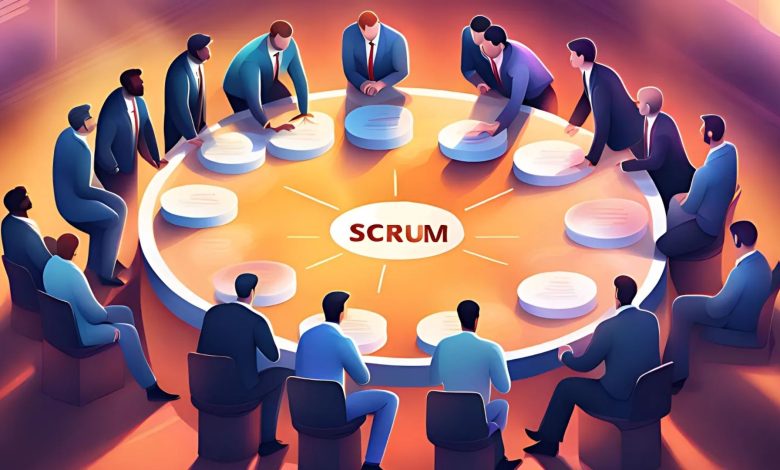SCRUM Method in Business Life

We know that authoritarian systems no longer yield results in the family, at school or in business life. While the word of parents, teachers or bosses used to be law, this system has slowly changed and new generations have begun to chart their own paths. Business life, instead of adopting strict methods as before and continuing in that way, wanted to adapt itself to the changing and evolving world. We had previously explained this transformation process and the changing business world in our article “Agility and Agile Processes in Business Life”. In that article, we discussed with you how Agile and Agility are implemented and processed in the business world. A new method was developed to implement these methods and agility at the highest level: SCRUM.
What Does SCRUM Mean?
“SCRUM” got its name from a game strategy in the rugby game. In this strategy, players come together to try to win the ball and are tightly connected to each other. In the context of software development, SCRUM also suggests teamwork, cooperation and coming together. The reason we say “suggests” in this sense is that SCRUM does not carry a methodology. SCRUM is more of an approach and is essential for many companies in terms of agility.

What is this SCRUM?
SCRUM adopts a flexible and iterative approach and divides projects into small pieces, or “sprints”. We can almost hear you shouting, “Stop! Stop!” Yes, that’s exactly what we said when we first learned it. What is a Sprint? What is Iterative?
Iterative means repetitive. An iterative process, a process, or a project consists of multiple repeated steps to achieve a specific goal. Each iteration aims to make improvements based on the results from the previous one.
Now let’s talk about Sprint. A sprint is a time period that usually lasts 2-4 weeks and aims to complete a specific goal or piece of work. The main components of SCRUM are the product owner, the SCRUM team and the SCRUM master.

Product Owner: Determines the vision of the product and defines the requirements from the beginning to the end of the project. The product owner represents customers and stakeholders and determines the features that need to be developed as a priority throughout the sprints.
SCRUM Team: A small, self-managed team. It consists of software developers, testers, and other relevant experts. The SCRUM team comes together throughout the sprint, completes work, and ensures continuous improvement of the product.
SCRUM Master: Manages SCRUM processes and applications. Removes obstacles, increases team efficiency, and ensures compliance with SCRUM principles.
SCRUM is often preferred in projects with rapidly changing and uncertain requirements. It adopts a flexible and customer-focused approach and ensures rapid delivery of products that consistently provide value to the customer.
Now, we have some empathy. If it were us, we would say, “Okay, that’s all well and good, but what exactly is done in SCRUM?”
SCRUM Process
Since SCRUM is not a clear methodology, each company using this method can plan differently, but there are common processes for everyone using SCRUM. A general SCRUM process includes the following steps:
- Planning: At the beginning of each sprint, the product owner and the development team meet and determine the work to be accomplished during the sprint. This includes determining the sprint goals and deliverables.
- Daily Stand-up Meetings: Each day, team members come together for a short meeting and share work completed during the sprint, work in progress, and obstacles encountered.
- Development: The SCRUM team works to meet product requirements throughout the sprint. As work is completed, it is approved by the product owner.
- Review: At the end of each sprint, the SCRUM team and the product owner come together and review the work completed during the sprint. Feedback is received and the product requirements are updated.
- Retrospective: After the review, the SCRUM team holds a retrospective meeting. In this meeting, challenges and improvement opportunities experienced during the sprint are discussed and actions are determined to improve the team processes.
These steps are repeated continuously, thus SCRUM follows the principles of flexibility, continuous feedback and continuous improvement. In this way, it is possible to respond faster to customer needs and ensure continuous development of the product.

With all these methods, the SCRUM process aims for companies to adopt an agile approach in the best possible way.
SCRUM provides a powerful framework for optimizing software development processes and adopting an approach focused on flexibility, collaboration, and customer satisfaction. Therefore, by correctly adopting SCRUM principles and practices, it is possible to successfully manage software projects and continuously improve products.
References and Further Reading
ACM Team. (2021, July 19). What is Scrum? . ACM Agile. https://www.acmagile.com/blog/scrum-nedir
Drumond, C. (n.d.). What is Scrum? [+ how to start]. Atlassian. https://www.atlassian.com/agile/scrum
What is Scrum?. Scrum.org. (n.d.). https://www.scrum.org/resources/what-scrum-module







